This photo comes from a 19th century Sanders & Fryher Photo album. If you can identify the date, age of the individual or who the person is, please post a remark about it.
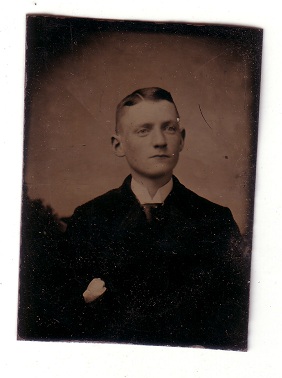
Last Monday we saw what type of information you might find within a Civil War Service record. This week we will explore what hidden genealogy nuggets may be contained within a Civil War Pension record. Either a Civil War Soldier or wife would be able to file for a pension. On rare occasions, even a mother or father would be able to file for their deceased son.
John Douglas Laurie enlisted in company E of the 10th Connecticut Infantry. This unit was one of the most successful of all the units in the Civil War from Connecticut. John was wounded and captured in a batlle on Dabrytown Road in Virginia on October 13, 1864. He was paroled a few days later and died of his wound on November 3, 1864. This left his wife Nicholas to provide care for five Laurie children and herself.
Nicholas (Martin) Laurie applied for a Widow’s Army Pension. She had to prove that she and John were actually married and that the five children were John’s. This proved to be a somewhat difficult task. John and Nicholas were married in Scotland. There first two children were also born there. A third child was born at sea as Nicholas was coming to the United States.
In the civil war pension file there were papers which were copied onto nineteen legal sized pieces of paper. One of the documents in the pension folder was the family bible entries for each of their John and Nicholas’ children. The bible enties list the date of each birth and where they were born.
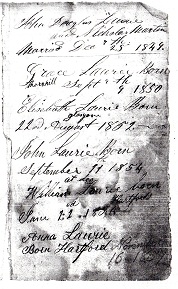
There were various affidavits testifying to the fact that John and Nicholas cohabitated like husband and wife. There was an affidavits from a reverand who baptised a few of the Laurie children in the United States.. Many of the documents were hand written and difficult to read.
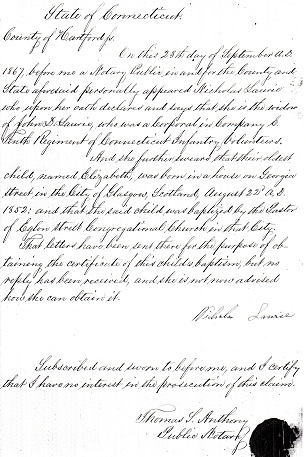
Here are some facts pulled from the pension file.
Ultimately Nicholas’ pension was approved. However she did not get credit for her oldest child while the amount of here pension was determined.
Edwin A. Banks served with his twin brother Edward A. Banks in the 2nd Connecticut Heavy Artillery during the civil war. He applied for and received a pension for his service in the early 1900s. A wealth of information was contained in his civil war pension records. A lot of the information was already known, but a number of additonal facts were learned. Edwin’s pension file consisted of sixteen legal sized pieces of paper. Each document in the file has the potential to contain just that missing piece of evidence you need. From one original declaration for pension document, the following facts can be attained. You will need to read and re-read each of the documents from the pension file.
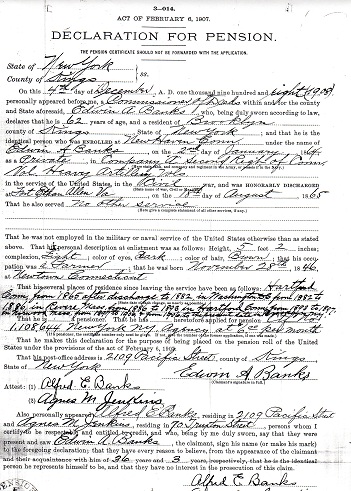
Military Service:
Places of residence:
Physical Description:
I had not known before that Edwin had moved to Washington DC. It happened in between the census and I had not found city directories to look for. Because the pension records put Edwin in Washington DC, I found he was working for the Federal Government. I was even able to find out how many hours he worked one year and what he got paid per hour. All that addiitonal information I would not have been able to find if it had not been for his pension record.
Here are just a few additional facts contained within Edwin’s Pension file
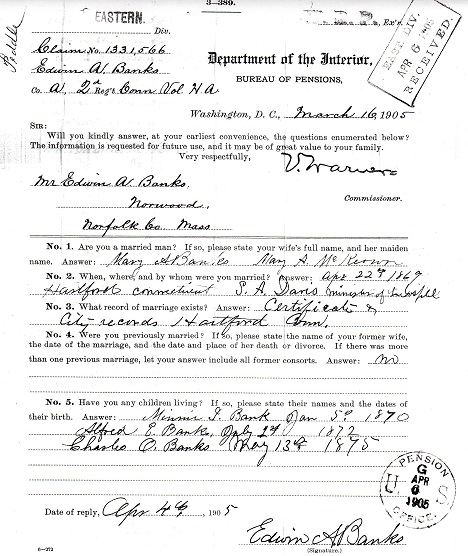
If you have civil war ancestors, order the full civil war pension file. You can hire a professional from the area to get them for you. You can save a lot of money this way and get the records a lot sooner than ordering them through NARA. There are a lot of hidden genealogy nuggets in civil war pension files.
Reverend Frederick W. Bailey compiled a significant portion of marriage records prior to 1800 from churches all over Connecticut. He started compiling these records in the very late 19th century and the compilation continued for quite some time. This work has been published in seven different volumes and is a great asset if you have ancestors in Connecticut.
The first of these volumes covered church records for;
Indexes to these church records have been loaded into our database here at Hidden Genealogy Nuggets. You can search volume 1 for free on this website.
——————-
Our affiliate providers help defray the costs of hosting this website. Please visit their websites and see what they have to offer.
Immigration was a life altering and often dangerous experience for our ancestors. There were numerous shipwrecks and miserable traveling conditions during the middle of the 19th century. Leslie Albrecht Huber does a fantastic job bringing her ancestors to life in “The Journey Takers”. The Journey Takers describe the lives of four immigrant ancestors of the author two from Germany, one from Sweden and one from England. Through Leslie’s words, you’ll relive the immigrant experience.
The stories start out in the old countries of Germany, Sweden and England. What brought them to make the decision to seek a new life in a new country? The book describes the lives of the journey takers (and some of their ancestors) in their homeland. You’ll experience what it was like to be a peasant at the time. There are many heartaches and joyous times. More than once, I had watery eyes.
The story is also intertwined with Leslie’s own life story as she tries to learn about her ancestors. You’ll relive her experience as she relates her own experiences to what the journey takers may have been experiencing in their lives. The way she relates her life experiences with those of her ancestors kept me wanting to keep read more.
——————-
Our affiliate providers help defray the costs of hosting this website. Please visit their websites and see what they have to offer.